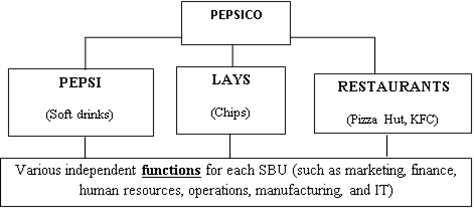Topics
strategic hierarchy, marketing orientation, strategic business units (SBU’s), growth pathways
Teaching Notes
- Preferred format: This teaching activity can be discussed in pairs, or could potentially be an individual student exercise.
- Student audience: This exercise is more suitable for students of introductory marketing.
- Exercise time: The exercise time should be around 5-10 minutes, plus any additional time for an overall class discussion.
Review the activity below or download the PDF student worksheet
- Student Worksheet: Strategy Hierarchy Levels
- Instructor Solutions (Members Only): Strategy Hierarchy Levels = Solutions
Student Discussion Activity
Introduction
In this exercise, you are required to determine at what strategy hierarchy level each of the following marketing decisions have most likely been made; choosing from corporate, strategic business unit (SBU) or functional (within marketing).
For this activity, we will use a former structure for PepsiCo (shown below the questions), as they are a firm with well-known SBU’s.

PepsiCo Strategy Decisions
- PepsiCo decides to sell their KFC chain.
- Lays introduces “tomato and cheese” flavored chips.
- Pizza Hut decides to discontinue its take-away (pick-up from a store) facility and ONLY offer a home delivery service.
- Bottles of Pepsi Max have a competition where the winners will golf with Tiger Woods.
- KFC launches a “fresh food” campaign, with new salads and grilled chicken, together with the slogan – “fast food – not fat food!”
- Pepsi builds a new $2 billion bottling plant in South Africa, in order to better supply the African market.
- Lays offers a special “two-for-one” deal on its salt and vinegar flavored chips.
- Pepsi decides to buy a chocolate factory and enter the confectionery market for the first time.
- Lays decides to stop distributing its products through schools.
- Pizza Hut launches its new peanut butter flavored pizza – for a limited time only
Student Discussion Questions
- Determine the strategy hierarchy level that you think each of these decisions have been made.
- Given that these marketing decisions are made at different strategic hierarchy levels, what are some of the implications of this, for a large organization (in terms of planning, implementation and internal communication)?
- Do you think that different firms would tend to have more centralized (corporate) or decentralized (functional) strategy decision making processes? Which approach would be more suitable in a dynamic business environment?
- What are the dangers of a firm being too centralized or too decentralized in their strategic approach?
- How appropriate is the strategic hierarchy model for a small business?